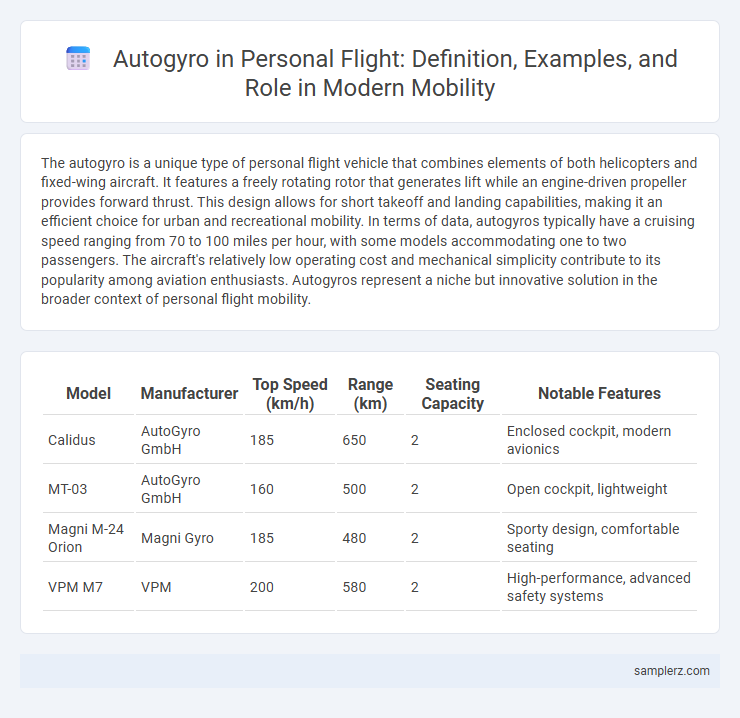The autogyro is a unique type of personal flight vehicle that combines elements of both helicopters and fixed-wing aircraft. It features a freely rotating rotor that generates lift while an engine-driven propeller provides forward thrust. This design allows for short takeoff and landing capabilities, making it an efficient choice for urban and recreational mobility. In terms of data, autogyros typically have a cruising speed ranging from 70 to 100 miles per hour, with some models accommodating one to two passengers. The aircraft's relatively low operating cost and mechanical simplicity contribute to its popularity among aviation enthusiasts. Autogyros represent a niche but innovative solution in the broader context of personal flight mobility.
Table of Comparison
| Model | Manufacturer | Top Speed (km/h) | Range (km) | Seating Capacity | Notable Features |
|---|---|---|---|---|---|
| Calidus | AutoGyro GmbH | 185 | 650 | 2 | Enclosed cockpit, modern avionics |
| MT-03 | AutoGyro GmbH | 160 | 500 | 2 | Open cockpit, lightweight |
| Magni M-24 Orion | Magni Gyro | 185 | 480 | 2 | Sporty design, comfortable seating |
| VPM M7 | VPM | 200 | 580 | 2 | High-performance, advanced safety systems |
Defining the Autogyro: A Breakthrough in Personal Flight
The autogyro, a rotary-wing aircraft using an unpowered rotor for lift and a separate engine-driven propeller for thrust, revolutionizes personal flight by offering enhanced stability and short takeoff capabilities. Its unique design enables safe, efficient travel at low speeds, making it accessible for private pilots and urban air mobility solutions. This breakthrough in aviation technology bridges the gap between helicopters and fixed-wing aircraft, expanding personal mobility options.
Historical Evolution of the Autogyro Concept
The autogyro, pioneered by Juan de la Cierva in the early 1920s, revolutionized personal flight by introducing a rotor system that provided lift without powered rotation. Early models like the Cierva C.4 demonstrated safe, controlled flight, bridging the gap between airplanes and helicopters. This innovation laid the groundwork for modern rotorcraft, influencing both recreational and urban air mobility technologies.
Key Features Distinguishing Autogyros from Helicopters and Planes
Autogyros feature unpowered rotors that generate lift through autorotation, contrasting with helicopters' powered rotors and airplanes' fixed wings. Their short takeoff and landing capabilities, combined with stable flight at low speeds, distinguish them as efficient personal flight vehicles. The unique blend of rotary and fixed-wing aerodynamics provides enhanced maneuverability and operational versatility in diverse flying conditions.
Popular Personal Autogyro Models on the Market
Popular personal autogyro models include the AutoGyro Calidus, known for its lightweight design and efficient performance, and the Magni M24 Orion, favored for its stability and ease of handling. The ELA Aviation ELA 07 offers versatility with its reliable engine and modern avionics, making it a top choice for recreational pilots. These models exemplify advancements in autogyro technology that enhance personal flight mobility.
Autogyro Flight Experience: Pilot Perspectives
Autogyro flight offers a unique personal flight experience characterized by slow, stable flight and excellent visibility, making it highly favored by pilots seeking recreational mobility. Pilots emphasize the autogyro's ability to take off and land in short distances, enhancing accessibility to varied terrains and expanding personal travel options. The combination of rotorcraft agility and fixed-wing principles provides an unparalleled control feel, contributing to pilot satisfaction in diverse flying conditions.
Safety Innovations in Modern Personal Autogyros
Modern personal autogyros incorporate advanced safety innovations such as ballistic parachute recovery systems and enhanced stability control technologies. These features significantly reduce the risk of accidents by providing emergency descent options and improved handling in turbulent conditions. Sensors monitoring rotor speed, engine health, and flight dynamics further ensure pilot awareness and prevent mechanical failures during flight.
Requirements and Training for Autogyro Pilots
Autogyro pilots must obtain a specific rotorcraft pilot license or add-on rating, which requires completion of ground school covering aerodynamics, meteorology, and aircraft systems, alongside practical flight training emphasizing autorotation, takeoff, and landing techniques. Flight training typically involves a minimum of 20 to 30 hours under the supervision of a certified instructor, focusing on handling unique flight characteristics and emergency procedures specific to autogyros. Pilots are also required to maintain proficiency through recurrent training and meet medical fitness standards to ensure safe personal flight operations.
Cost Analysis: Owning and Operating a Personal Autogyro
Owning a personal autogyro involves initial costs typically ranging from $70,000 to $150,000, depending on the model and customization options. Operating expenses, including fuel, maintenance, insurance, and storage, average around $5,000 to $7,000 annually, making it more cost-effective than many traditional aircraft. Fuel consumption for autogyros is relatively low, approximately 6 to 8 gallons per hour, contributing to their appeal in personal air mobility for budget-conscious enthusiasts.
Regulatory Considerations for Personal Autogyro Flights
Personal autogyro flights must comply with aviation regulations such as the Federal Aviation Administration (FAA) Part 103 in the United States, which governs ultralight vehicles including weight and speed limitations. Pilots are required to obtain proper certification, and the autogyro must meet stringent airworthiness standards to ensure safety during flight. Local airspace restrictions and no-fly zones also play critical roles in the regulatory framework for personal autogyro operations.
The Future of Autogyros in Urban and Recreational Mobility
Autogyros are transforming personal flight by offering compact, efficient alternatives for urban air mobility and recreational use, characterized by their vertical takeoff capabilities and low operational costs. Advances in lightweight materials and electric propulsion systems are enhancing autogyro range and safety, making them viable for short-distance urban commutes and leisure flights. Integration with smart air traffic management and dedicated vertiports is poised to elevate autogyros as key players in sustainable, congestion-free transportation solutions.

example of autogyro in personal flight Infographic
 samplerz.com
samplerz.com